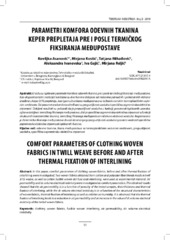Приказ основних података о документу
Parametri komfora odevnih tkanina keper prepletaja pre i posle termičkog fiksiranja međupostave
Comfort parameters of clothing woven fabrics in twill weave before and after thermal fixation of interlining
| dc.creator | Asanović, Koviljka | |
| dc.creator | Kostić, Mirjana | |
| dc.creator | Mihailović, Tatjana | |
| dc.creator | Ivanovska, Aleksandra | |
| dc.creator | Gajić, Iva | |
| dc.creator | Reljić, Mirjana | |
| dc.date.accessioned | 2021-03-10T14:09:56Z | |
| dc.date.available | 2021-03-10T14:09:56Z | |
| dc.date.issued | 2019 | |
| dc.identifier.issn | 0040-2389 | |
| dc.identifier.uri | http://TechnoRep.tmf.bg.ac.rs/handle/123456789/4297 | |
| dc.description.abstract | U radu su ispitivani parametri komfora odevnih tkanina pre i posle termičkog fiksiranja međupostave. Kao eksperimentalni materijal korišćene su dve tkanine dobijene od mešavine pamučnih i poliestarskih vlakana izrađene u keper 3/1S prepletaju, kao i pamučna tkana međupostava sa tačkasto nanetim termoplastičnim vezivnim sredstvom. Od parametara komfora određivani su propustljivost vazduha i specifična zapreminska električna otpornost. Dobijeni rezultati su pokazali da je propustljivost vazduha u funkciji poroznosti ispitivanih uzoraka, njihove debljine i termičkog fiksiranja međupostave, dok je specifična zapreminska električna otpornost u funkciji strukturnih karakteristika tkanina, termičkog fiksiranja međupostave i relativne vlažnosti vazduha. Registrovano je da termičko fiksiranje međupostave dovodi do smanjenja propustljivosti vazduha i porasta vrednosti specifične zapreminske električne otpornosti ispitivanih tkanina. | sr |
| dc.description.abstract | In this paper, comfort parameters of clothing woven fabrics, before and after thermal fixation of interlining, were investigated. Two woven fabrics obtained from cotton and polyester fiber blends made in twill 3/1S weave, as well as cotton fusible woven dot fuse coat interlining, were used as experimental material. Air permeability and dc volume electrical resistivity were investigated as comfort parameters. The obtained results showed that the air permeability is in a function of porosity of the tested samples, their thickness and thermal fixation of interlining, while the dc volume electrical resistivity is in a function of the structural characteristics of woven fabrics, thermal fixation of interlining as well as relative air humidity. It is observed that the thermal fixation of interlining leads to a reduction in air permeability and an increase in the value of dc volume electrical resistivity of the tested woven fabrics. | en |
| dc.publisher | Savez inženjera i tehničara tekstilaca Srbije | |
| dc.relation | info:eu-repo/grantAgreement/MESTD/Basic Research (BR or ON)/172029/RS// | |
| dc.rights | openAccess | |
| dc.rights.uri | https://creativecommons.org/licenses/by/4.0/ | |
| dc.source | Tekstilna industrija | |
| dc.subject | odevne tkanine | sr |
| dc.subject | tkana međupostava sa termoplastičnim vezivnim sredstvom | sr |
| dc.subject | propustljivost vazduha | sr |
| dc.subject | specifična zapreminska električna otpornost | sr |
| dc.subject | clothing woven fabrics | en |
| dc.subject | fusible woven interlining | en |
| dc.subject | air permeability | en |
| dc.subject | dc volume electrical resistivity | en |
| dc.title | Parametri komfora odevnih tkanina keper prepletaja pre i posle termičkog fiksiranja međupostave | sr |
| dc.title | Comfort parameters of clothing woven fabrics in twill weave before and after thermal fixation of interlining | en |
| dc.type | article | |
| dc.rights.license | BY | |
| dc.citation.epage | 19 | |
| dc.citation.issue | 2 | |
| dc.citation.other | 67(2): 11-19 | |
| dc.citation.rank | M52 | |
| dc.citation.spage | 11 | |
| dc.citation.volume | 67 | |
| dc.identifier.doi | 10.5937/tekstind1902011A | |
| dc.identifier.fulltext | http://TechnoRep.tmf.bg.ac.rs/bitstream/id/10048/0040-23891902011A.pdf | |
| dc.type.version | publishedVersion |

